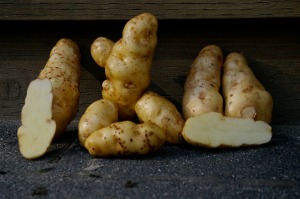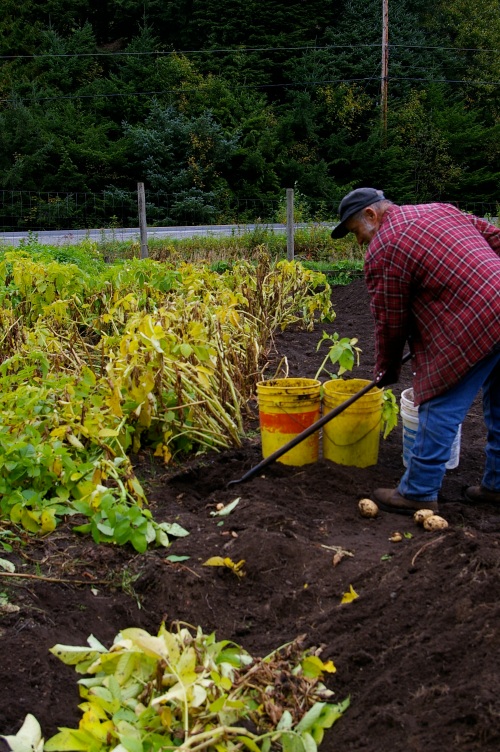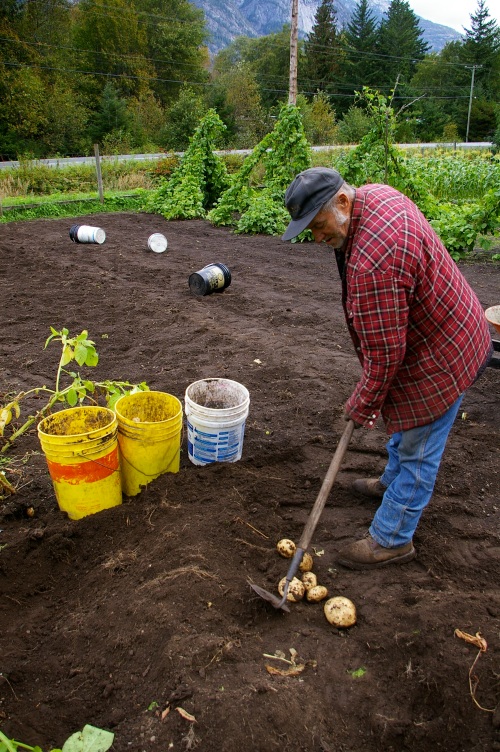as I know it!
September 21st, it was the last day of summer and I was down at my friend Clarence’s garden helping him harvest some potatoes. I had been by his place a few days before while he was harvesting some fingerling potatoes. He was unsure of whether or not he was going to bother with them. “I had these in my garden years ago but got rid of them,” he told me, “but now they’re back.” He shrugged, as if the potatoes had decided on their own to re-colonize his garden.
Today I was back to help harvest the tasty little beauties. (I also wanted to ensure I would have the seed for next year.) After searching through various web sites and photos of potato varieties, I found not only the pedigree of Clarence’s ‘Indian’ potato but also the reason behind the name. The original seed was obtained from Anna Cheeka, a Makah Indian of the Neah Bay Tribe, and introduced to the market by David Ronniger, of Ronniger Potato Farm LLC, in the late 1980s. According to their web site:
The Ozette is one of the tastiest of all fingerlings. Classic in appearance with pale gold skin and creamy yellow flesh. The slightly earthy, nutty flavor comes through beautifully when lightly steamed or sautéed. Late variety.
See Potato party for one for more on the Ozette potato.
While in Clarence’s garden, I noticed he was doing something foreign to me: placing the potato tops and any rogue weeds back into the hole where the harvested potatoes had come from. Having just harvested all of my potatoes and carried the potato tops, along with the weeds, to a compost pile inside my garden, I asked him about it. “I’ve always done it this way” he said, and then shrugging, “It’s what my dad taught me.” By spring, it would be rich soil, while my compost may not be completely biodegraded. “It feeds the worms too” he added as an afterthought.
I had thought that I was being clever by having the compost pile inside the garden, saving myself two steps: heaving the weeds and garden waste out to the pile, and then heaving it all back again in the spring as composted material. In the spring, I would simply spread it around the garden here and there and then turn the chickens in to do the rest of the spreading work. But what Clarence was doing eliminated both steps and produced a better result.
“You know, that soil scientist who was here last year? He told me I had the best soil in all the tests he’d done in the valley,” Clarence boasted while picking out a small rock as he continued to dig the potatoes.
This man has a system. A three-bucket system: One bucket for the ‘keepers’, one for the ‘rogues’, and one for the rocks. The keepers he stores enough for his family and sells the extras, the rogues he gives away to those who can’t afford to buy, and the rocks he disposes of. He’s been maintaining this system in this garden for longer than I’ve been alive. “You know, people say their gardens are too rocky for vegetables” he says while continuing to hoe, “So I ask them, Have you ever thought about digging them out?” He goes on to tell me about the thousands of rocks, small and large, that he’s taken out of here over the years. One of them was too large for removal he tells me, “So I spent nearly two hours digging a hole beside it …you know, and tipped it in” he stops hoeing long enough to give me a visual aid in gestures, and then nods towards an area in the garden, “It’s still in there, under the soil deep enough for my rototiller to pass over unscathed.”
Clarence is eighty-three. Originally from Pennsylvania, he is now a great-grandfather several times over. He has outlived his wife (but enjoyed a fiftieth wedding anniversary); survived the deaths of two children; endured 295 days as a POW “guest of Mr Hitler” as he likes to put it; lost his thumb end to a dynamite mishap at the tender age of 5; hunted countless troublesome cougars, and even got the better of one which attacked him on January 24th, 2000 (when he was seventy-four!). Luckily for me, he is also a master gardener keen to pass on his knowledge.
Like the Ozette potato, Clarence came north when young and flourished in a new climate. He too is a master survivor. No wonder he’s got the best soil in the valley!





